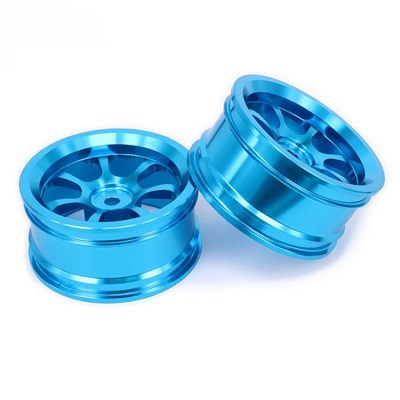Surface roughness of CNC machined parts
What is Surface Roughness
Factors Affecting Surface Roughness of CNC Machined Parts
Residual area
The area of the remaining uncut part of the two cutting edges on the machined surface is called the residual area. The larger the residual area, the higher the height and the greater the surface roughness value.
Dust accumulation
After the built-up edge is used for constant-speed cutting of plastic metal, because the built-up edge is both irregular and unstable, on the one hand, its irregular part replaces the cutting edge for cutting, leaving traces of different depths; The fallen built-up edge is embedded in the machined surface of the workpiece, causing it to form hard spots and burrs, and the surface roughness value increases.
Vibration
Periodic vibration of tools, workpieces or lathe components will cause periodic ripples on the CNC machining surface, and the roughness will increase significantly.
The method of reducing the surface roughness of CNC Machined Parts
If it is found that the surface roughness of the workpiece does not meet the technical requirements in production, the phenomenon of surface roughness increase should be observed first, the reasons for the occurrence should be analyzed, the main factors affecting the surface roughness should be found out, and then the solution should be proposed. Several common phenomena of surface roughness increase and solutions are introduced.
1. Increased surface roughness caused by the height of the residual area
The main declination angle and secondary declination angle of the tool should be reduced (generally, reducing the declination angle has an obvious effect on reducing the surface roughness), increase the radius of the tool nose arc, and reduce the feed amount
.
2. Burrs on the surface of CNC machined parts cause surface roughness to increase
Burrs on the surface of CNC machined parts are generally caused by built-up edge. At this time, the generation and growth of built-up edge can be suppressed by changing the cutting speed. For example, when using high-speed steel turning tools, the cutting speed should be reduced. Make it less than 5m/min, and add cutting fluid; when using carbide turning tools, the cutting speed should be increased to avoid the medium speed range (15-30-m/min) where built-up edge is most likely to occur. Therefore, the surface roughness of the front and flank surfaces should be minimized, and the tool should be reground or replaced in time to keep the tool sharp.
3. Chip workpiece surface
The surface of the workpiece that is scratched by chips is generally irregular and shallow. At this time, a turning tool with a negative edge inclination should be used to make the chips flow to the surface of the workpiece to be machined, and chip breaking or chip rolling measures should be adopted.
4. Vibration causes the surface roughness of the workpiece to increase
The solutions required to increase the surface roughness of the workpiece caused by vibration are as follows:
(1) Adjust the spindle clearance, improve the bearing accuracy, and adjust the large, medium and small slide plug irons to make the clearance less than 0.04mm;
(2) Reasonably select the geometric parameters of the tool, often keep the cutting edge clean and sharp, and increase the installation rigidity of the tool;
(3) Increase the installation rigidity of the workpiece. When clamping the workpiece, the overhang should not be too long, and the center frame should be used when clamping the slender shaft;
(4) Select a smaller amount of back cut and feed, or reduce the cutting speed.
5. Improve the properties of the workpiece material
The use of heat treatment technology to improve the properties of the workpiece material is an effective measure to reduce its surface roughness value. For example, the more uniform the grains and the finer the grain size of the metal structure of the workpiece material, the smaller the surface roughness value can be obtained during processing. For this reason, after normalizing or tempering the workpiece, the roughness of the machined surface can be significantly reduced.
6. Choose the right cutting fluid
The cooling and lubricating effects of the cutting fluid are both beneficial to reduce the roughness value of the machined surface, and the more direct one is the lubricating effect. The degree of plastic deformation of the metal material in the cutting zone decreases, thereby reducing the roughness value of the machined surface.
7. Choose the right tool material
Different tool materials, due to the difference in chemical composition, retain the hardness of the blade surface and the roughness of the blade surface when CNC machining parts, the affinity between the tool material and the metal molecules of the material to be processed, as well as the front and rear rake surfaces of the tool and chips and chips. The friction coefficient etc. between the machined surfaces are different.
8. Prevent or reduce process system vibration
The low-frequency vibration of the process system of CNC machined parts generally produces surface waviness on the machined surface of the workpiece, and the high-frequency vibration of the process system will affect the surface roughness of the process. In order to reduce the surface roughness value of processing, corresponding measures must be taken to prevent the generation of high-frequency vibration during processing.
CNC Machined Parts Company Name: Tuofa CNC Machining Inc
China Tuofa CNC Machining Inc - The best China top CNC machining manufacturer near you.
ISO9001/AS9100D/IATF1949 quality management system:
Precision manufacturing shops & supporting small batch production & allowing customers to order parts faster and easier.
Company Address: Building A, Esdlumen Technology Park, No.107, Huanguan South Road, Longhua District, Shenzhen, China, 518000.
< p>Company website: https://www.tuofa-cncmachining.com
Support Team: info@tuofa-cncmachining.com



评论
发表评论